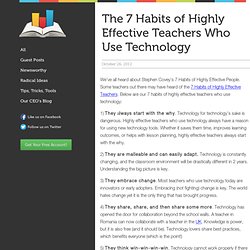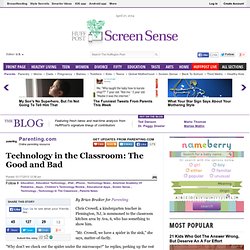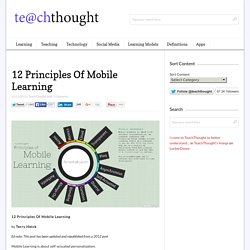

7 habits of highly effective teachersThe Always Prepped Blog. We’ve all heard about Stephen Covey’s 7 Habits of Highly Effective People.

Some teachers out there may have heard of the 7 Habits of Highly Effective Teachers. Below are our 7 habits of highly effective teachers who use technology: 1) They always start with the why. Technology for technology’s sake is dangerous. Highly effective teachers who use technology always have a reason for using new technology tools. 2) They are malleable and can easily adapt. 3) They embrace change. 4) They share, share, and then share some more. 24 Ed-Tech Terms You Should Know. If you’re a teacher or administrator who has been to an educational conference or sat in on a product demo featuring the latest classroom innovation, you know that the intersection of schools and technology is littered with buzzwords.
From mLearning to mobile apps to asynchronous instruction, the ed-tech landscape is equal parts high-gloss marketing and roll-up-your-sleeves instruction. In the face of increased pressure to improve student performance, how can K–12 educators cut through the promotional hyperbole and put the focus where it should be — on classroom improvements? It helps if you speak the language. This Ed Tech Cheat Sheet, which we first encountered on the Mr. G Online edublog, features 24 frequently used terms that teachers and other educators can reference when wading into discussions about the latest trends in educational technology. Why Teachers Want Technology (And Why They Can't Have It) - Edudemic. The Must-Have EdTech Cheat Sheet - Edudemic. 5 Ways Rapid Technology Change Impacts Education. How Rapid Technology Change Impacts Your Teaching by Terry Heick In an increasingly digital world (or increasingly digital human experience anyway), rapid technology change is a fact of life.

And these threats aren’t limited to business disruption, the safety of your data, or the digital footprint of your children. This kind of change also introduces significant threats to education. There is likely very little that can be actively done to reduce these threats on a macro scale other than impact them financially as consumers, as they are first economic issues. But we can begin to understand them better as teachers. 1.
Rapid technology changes increases the need for persistent, informal ‘PD.’ Technology policies, teacher growth plans, and even department structures are impotent against this rate of change, and this degree of fragmentation. 44 Better Ways To Use Smartphones In The Classroom. 44 Better Ways To Use Smartphones In The Classroom by John Hardison first appeared on gettingsmart.com This week an online article grabbed my attention.

Its title read “94 Percent of High School Students Using Cellphones in Class.” I immediately scoped out the heading and thought to myself, “Finally, teachers are beginning to embrace the powerful little gadgets.” However, it did not take me long to realize the researched article took quite a different slant. One quotation in particular caused serious professional introspection on my behalf. I understand the tougher task of using regular cell phones in class versus internet ready smartphones, however , I could not disagree more with the above quotation.
A blessed trip to the ISTE 2011 conference in Philadelphia helped me devise a BYOD classroom management plan and opened my eyes to the infinite educational potential of smartphones in the classroom. The Importance Of Mobile Learning In (And Out Of) The Classroom. 20 Essential Technology Terms for Teachers. In the essential reading Rethinking Education in the Age of Technology, authors Allan Collins and Richard Halverson state that the knowledge revolution has transformed our jobs, our homes, our lives, and of course our schools.

Now I know that most readers at Fractus are probably pretty tech-savvy, but still, some may not quite be to that level yet. The worst part about it is that the technology world moves so fast and changes so rapidly that the jargon and slang is extremely hard to keep up with, even for people who try to pay close attention. So today I thought I’d bring you a mini-encyclopedia or mini-dictionary of sorts, where I’ll lay out some of the more confusing technology terms that educators will encounter on a regular basis. I’ll do my best to explain them as well, so you can at least sound knowledgeable if you are, say, stuck in a conversation with someone who knows a lot about technology. Here we go! 1. Infographic Provides an Inside Look at the Modern Student. December 11, 2012 By: Mary Bart in EdTech News and Trends The Learning Life: An Inside Look at the Habits of the Modern Student was created by StudyBlue, a leading mobile study tool with more than 2 million users.
The data comes from a survey issued November 26-30 to the company’s users aged 15-22 attending high schools and colleges across the country. Some highlights to note: How Technology Has Impacted Education - Edudemic. A history of education technology. The Importance Of The Evolution Of Education 6.37K Views 0 Likes Over the past century, the modes of both imparting and receiving education have undergone a paradigm shift. The evolution of education has become more important than ever. Why TED Talks Have Become So Popular 5.67K Views 0 Likes TED talks are useful and free ways to bring high-level thinking and through-provoking ideas into the classroom and your home. The Evolution of Classroom Technology - Edudemic. Classrooms have come a long way.

There’s been an exponential growth in educational technology advancement over the past few years. From overhead projectors to iPads, it’s important to understand not only what’s coming next but also where it all started. We’ve certainly come a long way but some things seem hauntingly similar to many years ago. For example, Thomas Edison said in 1925 that “books will soon be obsolete in schools. How Children Used Technology 100 Years Ago - Edudemic. Parenting.com: Technology in the Classroom: The Good and Bad. By Brian Braiker for Parenting Chris Crowell, a kindergarten teacher in Flemington, NJ, is summoned to the classroom kitchen area by Ava, 6, who has something to show him.

"Mr. Crowell, we have a spider in the sink," she says, matter-of-factly. "Why don't we check out the spider under the microscope? " he replies, perking up the rest of the students, who are enjoying free play at various stations around the room. Ava carries the removable tub from the sink to the "teacher table," where Pedro, 5, launches the Zoomy digital microscope, a small, egg-shaped device that connects via USB cable to the classroom laptop.
12 Principles Of Mobile Learning. 12 Principles Of Mobile Learning by Terry Heick Ed note: This post has been updated and republished from a 2012 post Mobile Learning is about self-actuated personalization.

Technology: Bringing the world to schools - Good News from Finland. Good News from Thu, 11 April, 2013: What on earth do we need technology for in schools?

Surely, we can learn without it just as well. Finland has excelled in Pisa tests even though our schools don’t utilise information and communications technology to its full extent – yet. Young people have gone mobile. The Teacher's Guides To Technology And Learning - Edudemic.